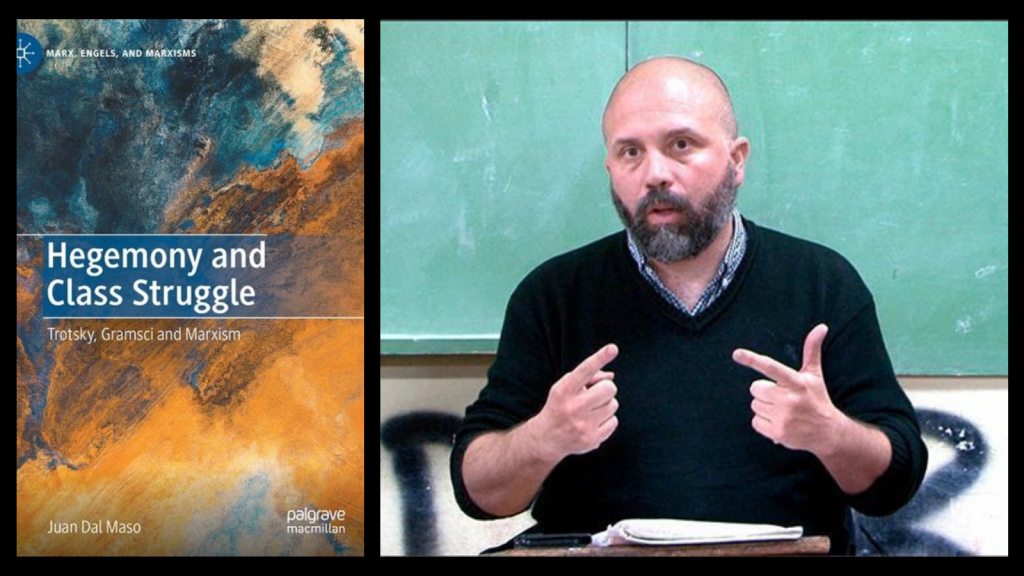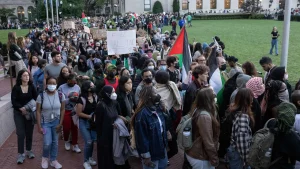This summer Palgrave Macmillan published the book Hegemony and Class Struggle: Trotsky, Gramsci and Marxism by the Argentinean Marxist Juan Dal Maso. Left Voice member Jimena Vergara interviewed Dal Maso, whose book deals with the concept of hegemony as articulated by two of the most brilliant revolutionary Marxists of the 20th century, Antonio Gramsci and Leon Trotsky.
The book’s table of contents, foreword, and epilogue are available online.
What is the central topic of the book, and why is it relevant to Marxist theory in general and in the United States in particular?
First of all, I would like to thank everyone at Palgrave and Springer, with whom I had the chance to work during the entire process leading up to the publication of the book, and especially Francesca Antonini and Marcello Musto, who believed that this work could be a contribution to the debate among English-speaking Marxists. I would also like to thank Warren Montag, who wrote a very generous foreword. He and I have an ongoing discussion about theoretical and political questions related to the Left in the United States, and, in general, our points of view converge on important issues.
The central topic of the book is the problem of hegemony, in some of its main aspects: as a relationship of leadership of the working class among other oppressed sectors, before and after the revolution, as a useful concept to understand interstate relations at an international level, and as how the bourgeois state seeks to re-create a mass base. The concept is still relevant to Marxist theory, for several reasons. Among them, the most important are the following: (1) Capitalist development tends to polarize society between the bourgeoisie and the working class, but this process is not absolute. There are still various social strata that do not exactly fit into one of the two fundamental classes and that, therefore, have specific demands. These demands must be met if we want to forge an alliance that can confront and defeat capitalism. (2) Capitalism is based on the exploitation of wage labor, but for its own benefit it also reformulates certain forms of extra-economic oppression, like the oppression of women and racism. (3) During the past few decades, as a result of the fall of Stalinism and its erroneous (and often malicious) association with communism, Marxist ideas have been discredited. As a result, new theories have gained ground, theories that focus on social movements or new subjects that would replace the working class as an agent of change (perspectives that are closer to different variants of autonomism), or theories that reinterpret hegemony with no connection to class and that aim to establish progressive political discourses first, and then populist discourses (Laclau and Mouffe). In some cases, these perspectives have been combined to promote a kind of collaboration between “social movements” and the state, as has been postulated especially in Latin America under the “post-neoliberal” governments or — despite the obvious differences — as some sectors of social movements propose today in the U.S. in relation to Biden’s government. So, by reexamining the question of hegemony in Marxist terms, we can once again put forward the centrality of the working class as a revolutionary subject. This in turn means taking up the demands of other social sectors affected by capitalism, both from the point of view of economic transformations and from the perspective of rights associated with matters of race, ethnicity, and gender. I think this is a fundamental question because, since the crisis of 2008, Marxism has recovered a certain amount of authority as a theory that can explain economic crises, but it has not yet regained its influence as a political strategy. I believe this discussion is particularly important for the United States, because the Marxist approach to the question of hegemony makes it possible to transcend the opposition (put forth, for example, by a sector of Jacobin but also by the leaderships of social movements) between “identity politics” and an economistic approach to the question of class.
Why did you decide to study Trotsky’s concept of hegemony and its relation to class struggle? What theoretically novel problems did you encounter in writing this book, and how was it influenced by the current situation of global class struggle?
In the various activities that we carried out to debate my first book, Gramsci’s Marxism, published in Spanish in 2016, I realized that there were no detailed studies on Trotsky’s specific conception of hegemony. So I started to research the topic more specifically. And several interesting questions arose. Trotsky’s use of the concept is original, fairly constant in his work, and at the same time relatively unsystematic. In his History of the Russian Revolution, Trotsky pointed out that, especially before the 1905 revolution, the Bolsheviks presented hegemony as the formula that would allow the Russian proletariat to lead the peasantry but without establishing a workers’ government. Lenin summarized this perspective in a government slogan, the “democratic dictatorship of the proletariat and the peasantry,” which was a kind of intermediate regime between a bourgeois government and the dictatorship of the proletariat. At the time, Trotsky was somewhat distrustful of the concept of hegemony. He used it occasionally, but with a different meaning than the one ascribed to it by the Bolsheviks (hence its originality): without disregarding the importance of the working class taking up the demands of the peasantry, he pointed out that it was just as necessary for the proletariat to fight with great determination for their own demands (and for their own government), as a way of leading the rest. Trotsky shared Lenin’s conception of the need to transcend economism through hegemonic politics. But he believed that (a) the specific demands of the proletariat had to be at the core of this hegemonic politics and (b) the dynamics of class struggle could create a profound social movement that would, in turn, have a political impact. If this had to be summarized schematically, it could be said that for Lenin hegemony was a political dynamic, while for Trotsky it was a political-social dynamic, which broadened the scope of politics.
You might be interested in: Trotsky, Gramsci, and the Emergence of the Working Class as Hegemonic Subject
In his balance sheet of 1905, he thus pointed out that the general strike and the soviets were expressions of working-class hegemony in the revolution. He subsequently referred to the question of hegemony in various books and articles, but he did not always use the concept. One example of this is when, in his History of the Russian Revolution, he defined dual power as a moment when all the hopes of the oppressed sectors were pinned on the working class, generalizing the question dual power and, with it, that of hegemony for all revolutions. So Trotsky uses the concept explicitly at times and implicitly at others, but he always associates it with the idea that the working class will be able to lead the other oppressed sectors by fighting very decisively for its own demands, in addition to taking up those of other classes. He also carries this over to the question of the transition to socialism, with respect to which he discusses the relations between the countryside and the city, between the proletariat and the peasantry in the USSR. In these discussions he highlights the importance of an economic policy that strengthens the social positions of the soviet proletariat and, at the same time, avoids totalitarian impositions against the peasantry. Finally, he also uses the concept to think about the relations between states, considering the different levels of military strength, the politics of alliances, and labor productivity. The first two chapters of the book cover these topics.
What can you tell our readers about the concept of hegemony in Gramsci, which is another one of the central themes of your book?
As Panagiotis Sotiris says in his very good review of the Spanish version of this book, the idea was to reconnect Gramsci with the traditions of revolutionary Marxism, showing that his ideas are incompatible with Eurocommunism or the policies of the second postwar PCI led by Palmiro Togliatti. To do this, it is essential to discuss the question of hegemony in his thought.
Gramsci’s concept of hegemony is more similar to Lenin’s than to Trotsky’s, especially because he emphasizes politics as a way to transcend corporatism. Gramsci also uses it to discuss the problems of the transition to socialism, international interstate politics, and revolution on a national scale. And he develops it much further to understand, on the one hand, bourgeois domination and, on the other, the working class’s relationship with the cultural heritage of the West.
In addressing the problem of bourgeois hegemony, Gramsci analyzes the changes in state forms in the interwar period. He constructs a conceptualization that shows the relationship between coercion and consensus as a form of traditional domination based on the parliamentary regime. He also explains the crisis of parliamentarianism resulting from World War I, the Russian Revolution, and fascism. The changes in state forms arise from the insufficiency of parliamentarianism as a hegemonic apparatus. This leads states to establish “corporate” forms of organization to bring unions and parties directly under their purview, These topics are addressed in the works of Fabio Frosini and in the most recent book by Francesca Antonini on Caesarism and Bonapartism in Gramsci.
These are questions that were also addressed by Trotsky, with regard to the incorporation of unions into the state in the late 1930s and, before his assassination in 1940, as an international phenomenon.
In the Prison Notebooks, class struggle is presupposed more often than it is explicitly mentioned, but one can easily identify an interpretation of the problem of hegemony in terms of the balance of forces (social, political, and politico-military), as in his well-known passage from Notebook 13.
Gramsci questions a mechanical interpretation of the Marxist concepts of base and superstructure and establishes a broader scheme in which he identifies three different levels in the balance of forces: social, political, and military. The conflicts arising from the balance of social forces take on a political character that is finally resolved from the point of view of a military confrontation. Hegemony is associated with the balance of forces in politics, but in reality it also operates in social struggle and war, especially in a civil war, in which social struggle takes the form of a military struggle, but for political purposes.
Gramsci also considers the question of hegemony with regard to the transition to socialism (as in various passages on Antonio Labriola or the question of “Reformation and Renaissance,” as well as in Notebook 13), reflecting on the importance of the commitments with allied classes, but without neglecting the economic centrality of the working class.
In this context, it is important to emphasize that it is incorrect to attribute to Gramsci the idea that the working class could achieve cultural hegemony over the entire society (including the bourgeoisie) as a precondition for carrying out the revolution or as a way to avoid it. Gramsci never took that position. His reflections on the construction of a new culture are directly related to the experience of the workers’ state. Of course, he attaches importance to ideological struggle as part of the struggle for hegemony, but as part of — and not as a replacement for — the balance of forces.
You might be interested in: Pablo Iglesias and his Gramsci ’à la carte’
In addition, Gramsci thought hegemony was the form that permanent revolution took on when all the classes were organized, states were much more integrated into the global economy, and the struggle for revolution faced much stronger state apparatuses than in Russia. But curiously, under the influence of Bukharin and the “struggle against Trotskyism” in the mid-1920s in the USSR, Gramsci believed that Trotsky’s theory failed to consider the problem of hegemony, a point on which he was wrong. In the third chapter of the book, I analyze in detail the 12 paragraphs of the Prison Notebooks in which Gramsci refers to Trotsky, and demonstrate in a documented way that his critique of Trotsky was largely unfounded. This does not prevent us from recognizing areas of convergence between the theoretical developments of both, because theory transcends the conjunctural positions of its authors.
How do you relate the thinking of both revolutionaries with respect to the concept of hegemony?
I see them as theoretical developments that mirror each other. While for Gramsci, as I said before, hegemony continues and perfects the idea of permanent revolution, for Trotsky hegemony is a component or a moment of it. The difference lies, in my view, in a conception of the revolution’s time frame. Gramsci conceives it as a slower process, so the “current form” of permanent revolution is thus the struggle for hegemony conceived as a long-term process (i.e., the struggle to establish working-class leadership among the masses, one that is sufficiently strong to alter the balance of forces in a revolutionary sense). For Trotsky, however, the development of class struggle can compress the revolutionary process, thereby shortening how long the struggle for hegemony takes. This is connected to the various ways that they reflected on strategic issues. But I think it is important to highlight the points of convergence between the two theories. In the fourth chapter of the book, I address the debates on Trotsky and Gramsci, especially Perry Anderson’s The Antinomies of Antonio Gramsci, and Gramsci and Trotsky in the Shadow of Stalinism, by Emanuele Sacarelli — which is, incidentally, a very solid book. It would be impossible to explain the debates with both authors in detail in the space of this interview, but I think the question can be summarized by saying that neither has given much consideration to the importance of Gramsci’s theoretical contributions and the possibilities of rethinking the relationships between them and Trotsky’s theory. In the epilogue of the book, I once again compare both positions, and I think that an important difference between Trotsky and Gramsci lies in the relationship between class and people. This has to do with the different ways that Italy and Russia entered modernity. For Trotsky, the Russian working class owes nothing to “national tradition,” which makes it possible to increase internationalism in the first phase: the Russian Revolution as a moment of the world revolution. For Gramsci, the history of Italy as the seat of the Catholic Church, the tradition of the Renaissance, and the limitations of state formation give more weight to the national problem, and to recover an internationalist position (which Gramsci calls “new cosmopolitanism”), it is necessary to establish an appeal to the people from the class, in such a way as to reconstruct a feeling of national identity, but deeply connected to a cosmopolitan role on the world stage.
As you know, in the United States, the editors of Jacobin magazine have revitalized Kautsky’s theoretical arsenal to justify a sort of renewed “strategy of attrition” for the socialist revolution in the United States. Many intellectuals argue that Kautsky’s strategy of attrition is a simile of Gramsci’s war of positions. What are your arguments to challenge this idea?
It was precisely Perry Anderson who contributed a great deal to the association of the Kautskian “strategy of attrition” with Gramsci’s idea of war of position, in The Antinomies of Antonio Gramsci. Of course, there are some superficial similarities between the two positions. Both Kautsky and Gramsci envision the revolutionary process as a long-term one. And they both criticized Rosa Luxemburg’s “spontaneity.” Their positions are, however, substantially different, basically because for Kautsky the strategy of attrition coincided with the gradual development of unions and parliaments, which excluded the military question. In fact, the “strategy of attrition” is not a strategy at all, just as Emilio Albamonte and Matías Maiello explain in their book Estrategia socialista y arte militar, because it doesn’t have the aim of defeating the adversary. On the contrary, for Gramsci, the “war of position” involved the three different levels of the balance of forces: social, political, and military. His conception is more like that of a partisan war than a combination of syndicalism and parliamentarism. This can be seen in Athos Lisa’s report on his conversations with Gramsci in prison, in which he explains in considerable detail the importance that Gramsci attached to the military question. Incidentally, it should be noted that the hypothesis that in Western revolutions the war of position would be more important than in Russia had been put forth by Trotsky himself in his discussions on “proletarian military doctrine.” Trotsky questioned the unrealistic position that maneuver warfare and a permanent offensive were the actions most suited to the proletariat’s revolutionary character. Gramsci considers the definitions of the Third and Fourth Congress of the Communist International and works on them, to gain a better understanding of the difficulties faced by the revolution in western Europe, but also in places where state forms take on a “totalitarian” or “integral” character, extending to social and trade union organizations. There are certain variations in the way he conceives the relationship between the war of position and the war of maneuver in the Prison Notebooks. He first presents them as two combinable forms of struggle, but he subsequently appears to oppose them and/or subordinate the war of maneuver to the war of position. Later, in his writings on the Risorgimento, from which he intends to draw useful lessons for the present, he returns to the idea of the combination of both forms of struggle. In short, if one wishes to seriously address the issue, it is much more complicated than presenting Gramsci as if he were Kautsky.
The United States was in turmoil in 2020. The BLM movement broke the inertia of the pandemic and exploded into one of the largest mass mobilizations in history with characteristics of a revolt, showing the potential and limits of what are referred to as social movements. How does your book contribute to the debate on the relationship between social movements, the working class, and hegemony?
Perhaps it would not be very appropriate for me to say to what extent the book contributes to this debate, especially since it refers to previous discussions in history and does not directly analyze the relationship between Marxism and the Black question. But what I can say is that all the processes of social struggle of the last decades, including some of those in which I was able to participate more or less directly as a member of the Socialist Workers’ Party of Argentina, are a necessary correlate of the reflections in this book. In particular, I think that in the history of the United States, the moments when the Black movement and the working class could unify their demands showed that there is great strength there, as Warren Montag and Joseph Serrano point out in their article “Socialism, Universalism and Anti-Anti-Racism.”
I would be very happy if this book only served to contribute to the fight of comrades like those of Detroit Will Breathe, who defend the importance of converging the labor movement and the Black movement, independently of the state and traditional parties. At the same time, I believe that it is essential to keep showing that Marxism is not an economistic and reductionist theory that seeks to ignore questions of race and gender based on a narrow view of social classes. We want to unify the struggle of the working class with that of all oppressed sectors to defeat capitalism. The division between “identity politics” and “economism” is the one that best suits the bourgeoisie and imperialism.











